An auger bit ?MikeG.":gm6ke9j0 said:So I'm outside with a 240V drill and a lump of 6x6 green oak, wanting to drill 50 or 60 twenty mm by 80mm deep holes in preparation for chiseling out half a dozen mortises. You've taken my spade bit off me.........what am I supposed to use?
Sent from my SM-G900F using Tapatalk





